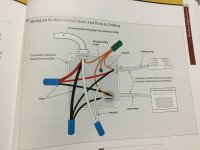Thank you in advance for your advice...
For a kitchen remodel I am replacing a range which is wired with a 50 Amp circuit an 6 AWG AL wire with a cooktop calling for a 30 Amp circuit and 20 Amp oven which will be installed below the cooktop.
I saw that the code allows these two to be wired on the same circuit, but has a description on how to wire it that I do not exactly understand. How would this connection look, can I join two 10/2 wires (or the pigtails from cooktop and oven) to the 6 AWG with some Polaris IPLG6-3B use them to wire up the two units?
For a kitchen remodel I am replacing a range which is wired with a 50 Amp circuit an 6 AWG AL wire with a cooktop calling for a 30 Amp circuit and 20 Amp oven which will be installed below the cooktop.
I saw that the code allows these two to be wired on the same circuit, but has a description on how to wire it that I do not exactly understand. How would this connection look, can I join two 10/2 wires (or the pigtails from cooktop and oven) to the 6 AWG with some Polaris IPLG6-3B use them to wire up the two units?
Last edited:

